The Fascination of Lilliputian Lines at Home and Abroad
RAILWAYS OF BRITAIN - 6
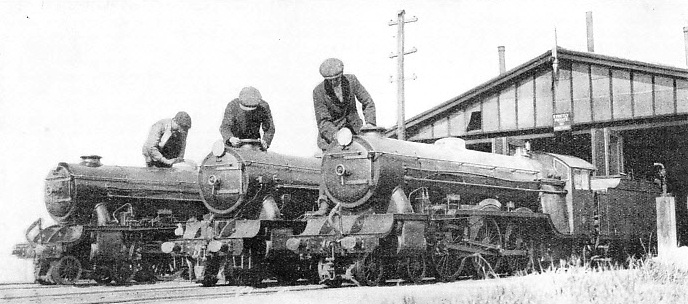
READY FOR THE ROAD. Preparing locomotives for the day’s work on the Romney, Hythe and Dymchurch Railway in Kent. These engines are one-third the size of the standard gauge main line locomotives.
MINIATURE railways are so often regarded as something of a novelty that it is not always realized that as much care and precision are required in their operation and control as in a full-sized line.
The Duke of Westminster’s light railway connecting Eaton Hall with the neighbouring Great Western Railway station at Balderton, near Chester, was the forerunner of the modern miniature railway. This line, built to a gauge of 15-in between the rails, was constructed in the late ‘eighties by Sir Arthur Heywood to demonstrate the usefulness of what he termed the “minimum gauge line”, which could be worked by steam locomotives. Sir Arthur had already constructed a short line of this gauge in the grounds of his own house at Duffield Park, near Derby, and had built several locomotives to run on it.
There were already “toy” railways, introduced by Americans, at various exhibitions, and quite a number of garden railways which were worked by externally perfect scale models of full-size engines.
In 1904-5 several 15-in gauge “Atlantic” 4-4-2 locomotives were built for various seaside resorts, including Blackpool, Southport and Rhyl, to work lines laid down for pleasure trips and light passenger transport.
The steam railway locomotive can be made to work quite as successfully in a small size as in a big one. It is not claimed, however, that the midget is as good as the mammoth, even when due allowances are made for differences in weight and fuel consumption. Size tends to make the large engine more efficient; but no radical difference in design is essential. It is rather the reverse. The miniature must be made with a proper locomotive type boiler, complete with inside water-spaced firebox and a relatively large number of fire-tubes from furnace to smoke-box.
Small but Efficient
The intensity of the steam exhaust up the chimney - the “blast”, as locomotive engineers term it - increases with load and gradient, no matter what size of engine is used. The driving of any locomotive, large or small, requires the same degree of skill.
The first of the 15-in gauge “Atlantic” locomotives, the “Little Giant”, was tested on the Duke of Westminster’s line at Eaton Hall. At this time the “Atlantic” or 4-4-2 type of engine was popular on our great railway systems and the advantages of the design were as apparent - even more so - in the model as in the original. The firebox, placed behind the coupled driving
wheels, could be made without undue restriction in length, and an ample grate area was obtained.
This engine was built to a scale of 3-in to the foot (one-quarter full size), and was of a “free lance” design conforming to no special prototype. It gave satisfactory service on the line at Blackpool, which was about a quarter of a mile long.
The four-coupled driving wheels measured only 18-in diameter, but so well did the engine perform when “full out” on a down grade that, on several of the test runs at Eaton Hall, over 26 miles an hour was attained, with perfect steadiness and freedom from oscillation.
The “Little Giant” was designed to haul trains of four open bogie coaches carrying 48 adult passengers - a total load of 3½ tons - on a level track.
The cylinders, 3⅜-in diameter by 6-in stroke, were placed outside the frames with the valves inside, actuated by Stephenson’s link motion reversing gear. The firebox had a grate area of 204 sq in, and the boiler worked at 120 lb per sq in.
The weight of the locomotive was only 1 ton 9 cwt in working order, and, in addition to the driver, it carried 56 lb of coal and 35 gallons of water in the six-wheeled tender. The driver had also to serve as fireman, and as there was insufficient room for him to stand on the footplate, a seat was provided in the tender. The flue tubes were ⅞-in diameter, and a smoke-box superheater was fitted. When at Blackpool the engine made 120 trips a day, carrying a maximum of nearly 1,500 passengers.
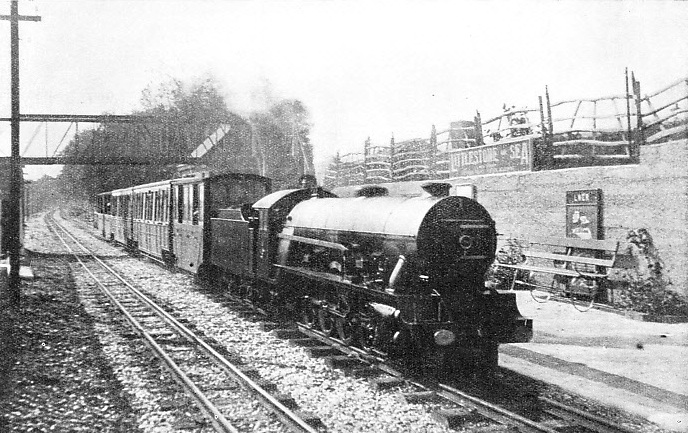
A WAYSIDE HALT at Littlestone-on-Sea, on the Romney, Hythe and Dymchurch Railway. The engine driver sits in the locomotive tender and looks out over the roof of the cab.
On another railway, built later at the Marine Park, Rhyl, North Wales, the best performance for the “Little Giant” type of engine was the hauling of 5,003 passengers by two locomotives in one day. The line consisted of a circular route one mile in circumference. At a later date some new engines were built at Rhyl for this railway. They were slightly larger, but still of the “Atlantic” type, and were provided with two cylinders 4¼-in diameter by 6¾-in stroke, and a boiler with a moderately wide firebox stretching over the trailing or rear carrying wheels of the locomotive. Nominally they were 50 per cent more powerful, and weighed 2 tons 10 cwt, instead of the 30 cwt of the previous “Little Giant” type engines.
The principles tried out at Eaton Hall, Blackpool, Rhyl and Southport were adhered to in the more powerful engines made for other lines in various parts of the country. At Eskdale, in Cumberland, the first locomotives for the light railway from Ravenglass to Dalegarth were of the “Pacific” 4-6-2 type. The increase of scale from 3-in to 3¼-in to the foot on 15-in gauge, and the use of larger cylinders and 20-in diameter, six-coupled wheels, made a big difference to the hauling power. The cylinders in these engines were made larger in both bore and stroke - 4¼-in diameter by 7-in stroke against the 31-in diameter by 6-in stroke of the “Little Giant” locomotives - but the boiler proportions were considerably increased.
A 200-ft Rise
The Eskdale line was originally built as a 3-ft gauge railway. It went out of use, but since the war its activities have been revived as a 15-in gauge passenger railway.
The original line was operated because of the iron ore found in the hills at the foot of Sea Fell. When the iron ceased to be worth mining the small amount of passenger traffic was not enough to make the line pay, with the existing type of rolling stock and engines.
The attraction of the new miniature express locomotives, however, brought hundreds to see the line and take a trip up the picturesque valley to Dalegarth almost every fine day during the summer months. The miniature locomotives were speedier than the lumbering old contractor type of engine used in the 3-ft gauge days, and more pleasing to the eye.
The line, in its miniature railway form, runs from the coast, the terminus station adjoining the LMS main station at Raven-glass, a village which was once a Roman port. At the re-opening the railway was run on the old permanent way material, the spikes being lifted and the rails drawn in to the new 15-in gauge. The railway , has since been relaid with new rails and sleepers specially designed to suit the 15-in gauge express engines.
The other end of the line, Dalegarth, is at the foot of Sea Fell, England’s highest mountain, which is on the road to Hardknott Pass. From Ravenglass the railway rises, steeply in places, nearly 200 ft in the seven miles run to Dalegarth.
When the line was opened, the locomotives were either of the enlarged “Little Giant” class or of the six-coupled “Pacific” type, but these engines have since been rebuilt. Two of them, the “Colossus” and the “Sir Aubrey Brocklebank”, were joined together to form an articulated locomotive, with engines and one boiler similar to the famous “Garratt” engines.
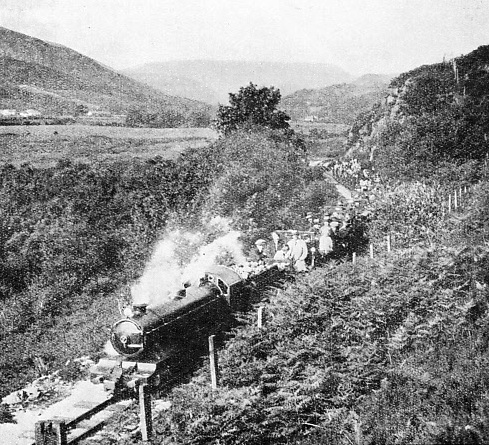
THROUGH BEAUTIFUL SCENERY. This excursion train is taking a party of travellers round Prospect Point on the Ravenglass and Eskdale Railway in Cumberland.
The Eskdale Railway introduced the “Lentz” poppet valve gear to this country in an engine named the “River Esk”. In the Lentz and similar poppet-valve motions steam is admitted to the cylinders, and released on exhaust, by means of lifting valves, instead of the slide-valves or piston-valves of ordinary locomotive practice. Since then Lentz valves have been applied to some forty main line locomotives in Great Britain, including the famous “Cock o’ the North” of the LNER.
About the time the “River Esk” was constructed, the Ravenglass and Eskdale Railway, to give it its full title, created a remunerative winter traffic by opening a quarry with a stone crushing plant alongside the line at Beckfoot. The “River Esk” was therefore built to an enlarged scale of 4-in to the foot (one-third full size). This locomotive was modelled on the lines of the GWR type eight-coupled mineral engines, with the exception that an extra pair of wheels, making it a 2-8-2 type locomotive, was placed under the firebox. To provide a large grate area and an ample capacity for fuel, this was of the “Wootten” or wide firebox type. Instead of the total weight of under 3 tons, this new locomotive weighed 7 tons 15 cwt in full working order. Although still a “scale model locomotive”, its proportions enabled the driver to be comfortably housed in a sitting position beneath the cab roof, a great improvement in the wet winter climate of the Cumberland dales.
The “River Esk” was suited both to the heavy passenger traffic during the summer months and to the hauling of the trains for the quarry during the rest of the year. The “Muriel”, one of the best of Sir Arthur Heywood’s eight-coupled tank engines
was rebuilt on the same lines as the “River Esk” with a bogie tender and a wide firebox boiler. It is now running in this condition renamed the “River Irt”.
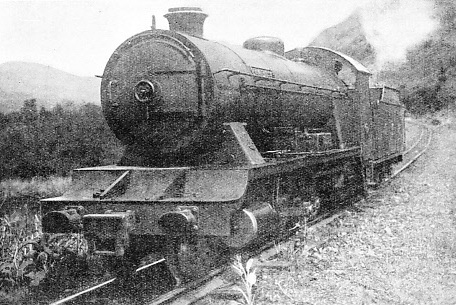
THE “RIVER ESK”, a powerful 15-in gauge locomotive on the Eskdale Railway in Cumberland.
The new engine hauled very heavy trains - on one occasion the total load was 252 passengers. Open coaches are used in the summer on the Ravenglass and Eskdale line. Passengers refuse to ride in anything else while it is fine, mainly because of the magnificent scenery through which the line passes. On the heavy grades with which the railway abounds the larger engines could deal with the trains more easily, and the “smut-throwing” difficulty experienced with the smaller engines was checked.
The “River Esk” engine has eight-coupled driving wheels 16½-in diameter, and outside cylinders 5¼-in diameter by 8½-in stroke. The small carrying wheels are arranged in pairs at either end, and are fitted on swivelling “pony-trucks” to allow for negotiating sharp curves. The tender is a double bogie vehicle with a well in the front for the driver’s legs. Instead of standing on the footplate, as he would do in a full-size engine, he sits on it, and is therefore well able to place himself inside the 40-in high by 36-in wide driver’s cab.
The boiler is just under 2-ft diameter with a firebox 2 ft 1-in by 2 ft measured at the grate. Inside it is fitted with 49 tubes of 1⅛-in. diameter. This locomotive is capable of hauling a load of 200 or more passengers from Dalegarth to Ravenglass, seven miles nonstop, but mostly downhill, with only one intermediate replenishment of the fire.
Many useful experiments have been conducted at Eskdale. Simple vacuum brakes in a miniature size were made to suit the Eskdale engines and trains, and this led to the export of these fittings for use on several of the continental miniature railways which followed the opening of the British lines.
Oil Firing
Oil firing was tried on one of the smaller engines, “Sanspareil”, an “Atlantic” 4-4-2 locomotive of the improved “Little Giant” type. The idea was to do away with the “smuts” to which front passengers in open coaches were exposed. The smell of the oil, however, proved to be much more objectionable.
Another innovation was the use of slip coaches. The morning down express carried passengers for a combined rail and coach tour, organized under a ticket issued by the main-line railway. These “slip” carriages were released as the train passed through the station at Irton Road where the motor-coach to Wastwater awaited them. Wastwater is an expanse of water on the western side of the Lake District.
All the more recent carriages are teak-built four-wheeled coaches carrying eight adult passengers. On 15-in gauge it is safe to carry only two passengers abreast at high speeds, and therefore light carriages without bogies were found to be the best. The largest number could thus be carried within the given limits of length and weight.
An equally famous miniature line is the Romney, Hythe and Dymchurch Railway, which runs between Hythe (Kent) and Dungeness Lighthouse.
The first two locomotives on this line were similar to the “River Esk”. The engines had been tested on the Ravenglass and Eskdale line, and the “Pacific” type wheel arrangement (4-6-2), the piston-valve cylinders and the Walschaerts valve gear, with which the locomotives were fitted, proved eminently satisfactory in this small size.
The site of the Romney Marsh railway had at one time been proposed for a tramway by the former South Eastern Railway, but the company abandoned their powers. These were revived by the Miniature Railway Company (finally known as the Romney, Hythe and Dymchurch Railway) as a double-line railway of 15-in gauge. The railway line from New Romney to the other Cinque Port of Hythe is 8¼ miles long, and quite level.
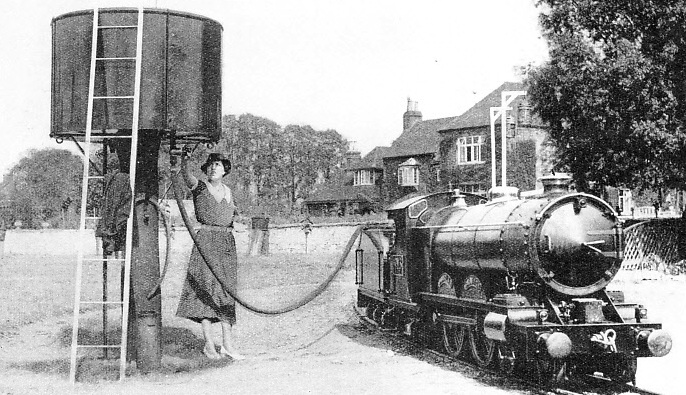
FILLING THE WATER TANK. This engine, of a free-lance design in its external lines, weighs six and a half tons and runs on a 15-in gauge garden railway near Tewkesbury, Gloucestershire.
The original engines of the Romney Railway were the “Green Goddess”, “Northern Chief”, “Southern Maid”, all two-cylinder “Pacifics”, “The Bug”, a four-wheeled shunting engine, “Hercules” and “Samson”, 4-8-2 mixed traffic locomotives, and “Typhoon” and “Hurricane”, three-cylinder “Pacific” locomotives.
American Engines
The engines also include two American type express locomotives with the “Pacific” 4-6-2 wheel arrangement and bogie “Vanderbilt” style tenders with cylindrical water tanks. In the main, the latter are identical with the standard British outline “Pacific” locomotives, their externals, the tenders and the design of the trailing wheels differing only in detail. The line was laid on marshland, and met with the difficulties common to such a site. There had to be a few level crossings, although it was possible to cross the two main roads at Romney and Hythe by concrete overbridges. The same track as used at Eskdale was adopted - flat-bottomed 24 lb rails laid on full-size section (9-in by 4½-in) sleepers cut down to 3 ft lengths before creosoting. For all passenger-carrying miniature railways both rails and sleepers must be much larger than the scale equivalent of the locomotives to provide a reliable track.
Several of the main drainage canals and dykes on the Romney Marsh had to be crossed in the course of building the eight miles of line. The largest of these was adjacent to the Duke of York’s summer camp at Jesson. The bridge is a single 56-ft span, “N” girder, of the skew type, constructed in steel and resting on reinforced concrete abutments. The road over-bridge at the Warren has two 50-ft tunnels, and was built in reinforced concrete in five and a half weeks. There is also a special extension of the Southern Railway into the Romney, Hythe and Dymchurch Railway’s yard, and this was of considerable help in receiving transports of materials from the main line during the work of construction.
Low Fuel Costs
While the railway was being built, the Duke of York visited his boys’ camp at Jesson, Dymchurch, and expressed a desire to see the line. Special efforts were made to complete the 56-ft span girder bridge, which then connected up New Romney with the boys’ camp, before the appointed day. This feat was accomplished, and the Duke was able to cross the bridge and drive the first train to New Romney. The line was then, of course, not officially open, but this Royal “christening” gave some indication of the interest taken in the venture and foreshadowed its highly successful opening and first year of traffic.
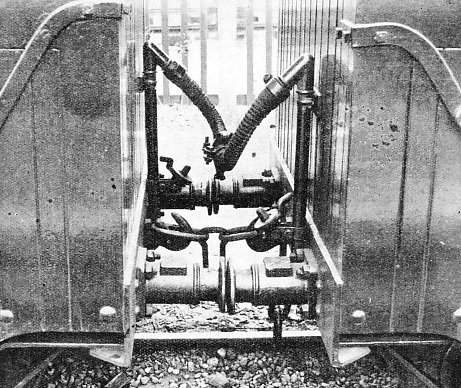
MINIATURE VACUUM BRAKES are fitted to the trains of the Romney, Hythe and Dymchurch Railway. The vacuum pipes are coupled as shown, between the coaches, and beneath them is the special T coupling link which enables the buffers to be drawn in close contact - a necessity on systems using automatic brakes.
During the year following the opening the seven engines ran, without any serious breakdown, 106,121 passenger-train-miles on a consumption of about 11½ lb of Welsh coal a mile, including that used for lighting-up and shunting purposes. Over a quarter of a million passengers were carried. Fuel costs proved therefore a negligible quantity in miniature railway work. An expenditure of 2¼d a mile for coal is not a serious item for a locomotive that can haul a fifteen-coach train, seating 120 passengers, at twenty-five to thirty miles an hour.
For winter services the Romney line ordered a series of closed-in bogie coaches, measuring over 20 ft in length. Their construction was similar to that of ordinary main line carriages, with compartments and side doors, but owing to the exigencies of the gauge and the presence of the two bogies at the ends, it was impossible to carry more than twelve passengers per coach for a tare weight of 2 tons 10 cwt. The average train is composed of two coaches only, and with a luggage truck is quite within the pulling powers of the locomotives. But owing to their weight the enclosed carriages are not used on the fine days of the holiday season when, very often, there is a crowd of 300 passengers waiting for trains.
Then the light four-wheelers, or the equivalent articulated carriages, are used. These coaches are ten feet in length and carry eight adults or twelve children. They weigh only 17 cwt each. As the Romney, Hythe and Dymchurch Railway came under the jurisdiction of the Ministry of Transport, the signals and the brake system had to conform to the statutory regulations governing the. construction, equipment and operation of railways. It was decided, therefore, to convert the simple vacuum brakes as used on the Eskdale line to the fully automatic scheme employed on main line railways. This was successfully accomplished, and specially small ejector apparatus and power cylinders were devised.
With automatic brakes, which work instantaneously if there is a breakaway in the train, a tight coupling between the carriages is essential. The use of screw couplings as on full-size railways was not a satisfactory proposition, and a special three-link coupling was experimented with. The centre link of the chain is a “T” shape and allows for either a slack or a tight coupling.
Miniature “Flying Scotsman”
When the line was completed the new three-cylinder locomotives “Typhoon” and “Hurricane” were received from the builders. Although, in common with the other “Pacifics”, they were modelled on the lines of the LNER “Flying Scotsman” locomotives, the later miniatures were provided with three high-pressure cylinders as in the prototype. As a result, there-fore, they were nearly fifty per cent more powerful than the two-cylinder engines, and “Typhoon” proved this by working a train carrying the record number of 327 passengers from Dymchurch to Hythe.
The dimensions of these “Pacifics” are as follows: The six-coupled driving wheels are 25½-in diameter on the treads, the bogie and tender wheels 12-in diameter. The cylinders are 5¼-in diameter by 8½-in stroke, the same as those of the two-cylinder “Pacifics” and mixed traffic engines. Walschaerts valve gear is used for the outside cylinders, and the Greenly-Joy gear for the inside cylinders. The total length is 25 ft 1½-in over the buffers. The standard wide-firebox boiler is used, and the bogie tender carries the driver, 1½ cwt of coal, and 190-gallons of water. To feed the boiler two steam “injectors” are used.
The average time allowed for a stopping train from Romney to Hythe is thirty minutes, an average of 17¼ miles an hour. Ignoring stops - about seven minutes in all - the running speed is 22½ miles an hour.
To accomplish this it is often necessary to attain a speed of 32 miles an hour during the journey. At the trials at Eskdale 35 miles an hour was accomplished, and it is estimated that on a good stretch of level permanent way 39 miles an hour would be the maximum. This would be approximate to over 100 miles an hour in the prototype.
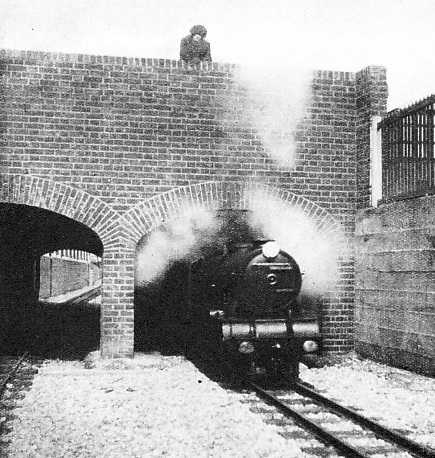
A MINIATURE BRIDGE carries the road over the double track of the Romney, Hythe and Dymchurch Railway. The arches have a head clearance of only six feet.
The Romney line has several overbridges. In view of the flat nature of the Romney Marsh, the railway could not be laid in cuttings or under roads, as it would have been waterlogged. But at Romney and Hythe there are road over-bridges, though these have a head room of only six feet. The summer coaches, which are nominally open carriages, had therefore to have a protective roof to prevent people standing up on the seats and coming into contact with the tunnel tops. This very small “loading gauge”, as the limits of total height and width are referred to in railway circles, has also allowed the line to be extended under the road at Littlestone to the famous Lighthouse at Dungeness. This was done within two years after the opening of the line. From Dungeness the route is an open stretch of sand-dunes and shingle banks. At Littlestone Road, not only had the water difficulty to be fought, but there was also a forest of pipes to be diverted. To facilitate the handling of trains, the terminus at Dungeness was made in the form of a large loop, 1,120 ft diameter, and turn-tables for the locomotives were unnecessary. The long platform will accommodate two trains, one behind the other, and the first in can be the first out without involving the turning of engines or other shunting difficulties.
With the Dungeness double-line extension, the total length of single line track amounts to twenty-eight miles. Its construction involved the use of 1,180 tons of rails, 60,000 sleepers, and nearly half a million spikes. At New Romney, engine and car sheds and workshops were built. In addition dwellings for the staff and refreshment rooms for the public were provided.
Signalling also received the attention of His Majesty’s Inspector for Railways; and for Hythe and Romney the signals were modelled on the standard railway practice with properly interlocked levers and points. Developments are still proceeding, and many interesting experiments have been made with petrol-driven locomotives. One of these engines is a converted Rolls-Royce car.
From the foregoing descriptions it is clear that both the Ravenglass and Eskdale and the Romney, Hythe and Dymchurch Railways are no mere toys. On the contrary, they fulfil all the functions of full-size railways, and both attain to the dignity of having their train services included in the pages of “Bradshaw’s Guide”.
On 15-in Gauge
These railways have proved the contention of Sir Arthur Heywood that practical railway operation is possible on a gauge as narrow as 15-in; so convinced was he of the future of the 15-in gauge that he built a restaurant car and a sleeping-car containing four full-length berths to run over this diminutive track. The sleeping-car spent some time in Eskdale in the early days of the conversion to the narrow gauge, and has served as reserve sleeping accommodation for the staff on several occasions.
To-day the Eskdale Railway, despite road competition, still provides the principal communication between this populous valley and the LMS line at Ravenglass. Most of the stores for the villages are taken up by train. In winter, when there is very little passenger traffic, the steam locomotives are stowed in the locomotive shed at Ravenglass, and most of the work of the line is carried on by the petrol-driven tractors. The fastest vehicle on the line is also pressed into service for passenger purposes. This is a double bogie car driven by the engine of a Ford 20 hp motor, which has travelled down from Dalegarth to Ravenglass in fourteen minutes, at an average speed of nearly thirty miles an hour, with various slowings for curves, and has reached a maximum of nearly forty miles an hour.
While the Romney, Hythe and Dymchurch Railway was being constructed, several “Pacific” engines were built and subsequently run on railways in the cities of Antwerp, Cologne and Munich. The scale and tractive power of these engines was about the same as that of the Eskdale Railway locomotive “River Esk”, except that they were six-coupled machines and arranged to negotiate sharp curves. They were equipped with English-made vacuum brakes and other fittings.
On certain other miniature railways the locomotives have “steam” outlines, but rely on petrol or Diesel crude oil engines for their propulsion. One of the earliest ventures of this kind was by the late C. W. Bartholomew, of Blakesley Hall, near Towcester, in Northamptonshire. He laid a 15-in gauge railway to connect the Hall with the Stratford-on-Avon and Midland Junction Railway (now a part of the LMS), at Blakesley Station, in order that coal and other stores might be brought up to the Hall in this way. To work the line he had built a locomotive designed externally as a 4-4-4 tank engine, but driven by a petrol motor, which worked the traffic successfully.
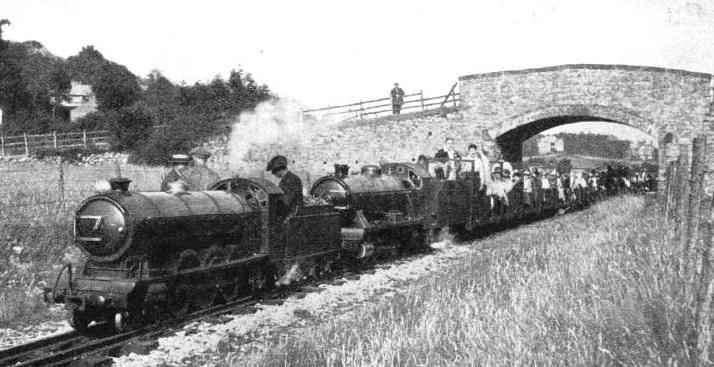
DOUBLE HEADING. Two fine locomotives with a train-load of holiday-makers at Irton Road Halt on the Eskdale Railway.
The same principle has been adopted by the Scarborough Corporation on the popular railway which has been laid down in the pleasure gardens on the North Bay at that resort. Here, to give more accommodation in the trains, a wider gauge of 20-in has been adopted, but the engines, modelled on the “Flying Scotsman Pacifics” of the LNER, are one-third full size, similar to those of the Romney, Hythe and Dymchurch Railway.
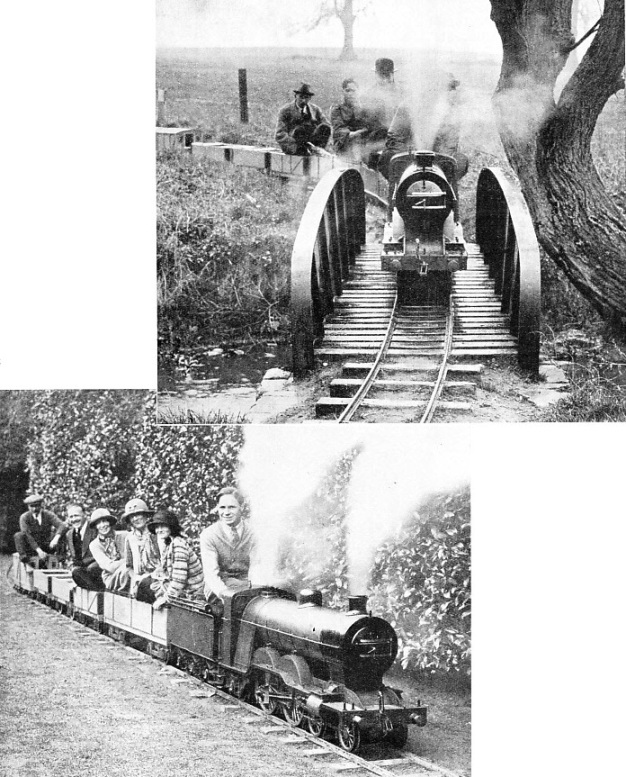
A GARDEN RAILWAY. At Broome, near Stourbridge, Worcestershire, a model railway was built for miles round a garden. The line was provided with its own small-scale tunnels and stations. Here a train on this line is seen crossing a bridge over a stream.
A MIDGET EXPRESS. Another view of the miniature railway at Broome, shown above. This engine is capable, despite its small dimensions, of hauling a train of cars carrying as many as thirty people. The engine is driven from a seat on the tender and is here shown with a white feather of steam escaping from the safety valves.
They are driven, however, by Diesel engines instead of by steam.
Each locomotive, in working order, weighs about 10 tons - 7½ tons for the locomotive and 2½ tons for the tender. The tender carries 440 gallons of water, which is used for cooling the engine. This is a 4-cylinder 26 hp engine working on crude oil. An interesting feature of this locomotive is a separate petrol motor to drive an air pump supplying the main reservoir of the Westinghouse automatic brakes, which are fitted to both the engine and the train. The coupled wheels of the engine are 28-in diameter and the overall length of locomotive and tender is 24 ft.
Each passenger coach seats about twenty passengers, two aside. An average train comprising four carriages holds some eighty passengers who travel in complete comfort. The line starts from Peasholm, skirts the hills and lake, and, passing through a short tunnel, continues along the North Bay beach to the terminus three-quarters of a mile distant, at Scalby Mills. Peasholm Station comprises the offices of the railway, the engine and car sheds, and loop lines which enable loco-motives to be turned round at the end of a run without the use of turn-tables.
Another miniature railway employing Diesel-engined locomotives for running the trains is the “Golden Acre” miniature railway, which is situated in a pleasure park on the outskirts of Leeds. This is about half a mile in length and is also built to the 20-in gauge. The locomotive resembles in appearance a 4-6-4 tank engine and is driven by a 26 hp engine. The length of the locomotive is 18 ft 3-in.
At Great Yarmouth a railway of 15-in gauge has been built for pleasure rides on Yarmouth beach, and is 600 yards long, laid out in the form of an elongated loop. On leaving the station the train, having traversed a curve of about 90 ft radius, runs down a 1 in 80 incline to a tunnel thirty-three yards long. After it has emerged from the tunnel the line climbs a gradient of
1 in 72, and then returns to the station. On this railway the engine is turned round after its trip by means of a turn-table at the station. The points and signals are operated by hydraulic power, and all the signals are interlocked with the points, as in a full-size railway.
Both Diesel and steam power are used on the Great Yarmouth line. The steam locomotive is of the “Atlantic” type, with
18-in driving wheels. This engine has two cylinders 3½-in diameter by 6-in stroke, supplied with steam at a pressure of 120 lb per sq in. As many as sixty passengers have been carried in one train by this engine up the 1 in 72 incline, the total load, including the locomotive and tender, being about eight tons. In addition to the open coaches a train of closed carriages has also been provided for use in wet weather.
Weighs 3½ cwt - Pulls 1 ton
Passengers can be carried, however, on gauges narrower than 15-in. One of the smallest of seaside miniature railways is the 7¼-in gauge line at Mablethorpe, Lincolnshire, on which trains run regularly throughout the summer months. The track is laid in the form of an oval, about 900 ft long, and is provided with rails of the same bullhead section - in miniature - as those used on full-size lines. The rails are held by wooden wedges in chairs which are fastened to wooden sleepers. Leaving the main station, the line is carried over a viaduct, then through a tunnel, over a lattice-girder bridge, and finally through a longer tunnel and back to the station. All the signals on this line are operated by electricity. Among the engines used to haul the trains, one is a 4-6-2 express engine, weighing 8 cwt, which is capable of hauling a load of three tons. The working pressure of the boiler is 100 lb per sq in and the two cylinders are 2¼-in bore by 3½-in stroke. Another engine on this line is a model 4-4-0 type weighing only 3½ cwt, which is capable, however, of pulling a load of one ton.

IN AUSTRALIA. This miniature railway is laid in a garden at West Melbourne. The photograph shows the builder driving his small-scale “Pacific’’-type locomotive.
Among privately-owned lines, one of considerable note is that at Radwell, Bedfordshire, owned by Mr. H. F. R. Franklin, a partner in the well-known model-building firm of Bassett-Lowke, Ltd. This is a railway of 10¼-in gauge, the two engines of which have been built to a scale of 2-in to the foot. The line itself has a length of about three-quarters of a mile, and is arranged in the form of a large circle over some undulating ground. This has necessitated an embankment nearly 8 ft high and a viaduct 65 ft long, with four 16 ft spans. The steepest gradient is 1 in 40.
“Loadstone”, the principal locomotive, is an “Atlantic” modelled on the lines of the three-cylinder 4-4-2 engines of the old North-Eastern Railway. It has driving wheels 11½-in diameter, and two cylinders with a diameter of 2⅝-in and a stroke of 4½-in, and the boiler works at a pressure of 100 lb per sq in. Overall the engine and tender measure in length 11 ft 9-in, and weigh 35 cwt. “Loadstone” has been tested up to the remarkable maximum speed - for an engine one-sixth full-size - of 25 miles an hour. Two injectors and mechanical lubrication are provided, and the diminutive boiler supplies superheated steam to the cylinders.
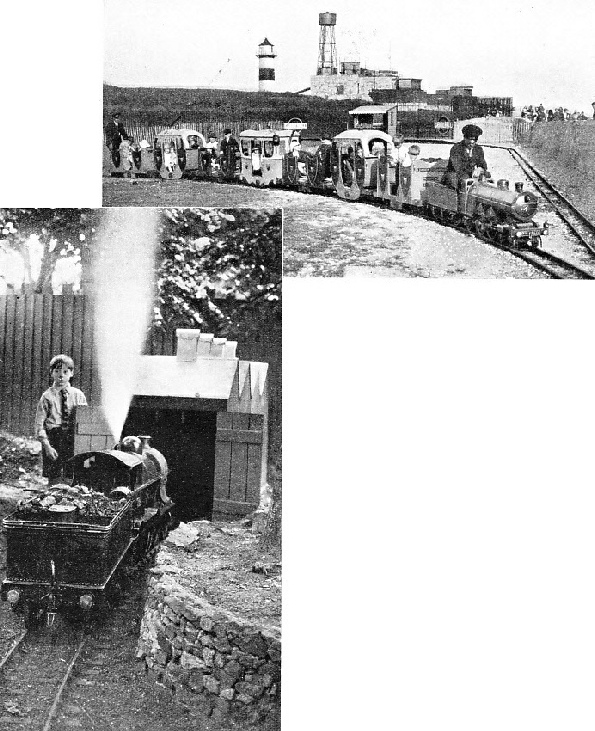
YOUNG HOLIDAY-MAKERS (above) enjoy this miniature line at Southsea, Hampshire. Although the rolling-stock on the railway is of a novel pattern, it meets with the approval of its youthful passengers.
RUNNING INTO ITS SHED (left). This engine runs on a garden railway at Crewe. The locomotive is a well-built model of the old London and North-Western Railway’s four-cylinder compound type.
Some interesting tests have been carried out on this line, and they have supplied the builders with valuable data for the design of engines for this and other miniature railway gauges. One of the most remarkable of these tests was a non-stop run which began at 4.53 in the afternoon and finished at 6.54pm, a period of two hours. Before starting, the tender was filled to its full capacity of 16 gallons, which sufficed for a run of 29¾ miles. The average speed of this journey was, there-fore, all but 15 miles an hour for two hours - an extraordinary feat for an engine of this size - and if proportioned out to full size would work out at 88¼ miles an hour for the whole distance. Four empty bogie coaches constituted the load.
In addition to the open coaches mentioned, each seating four passengers, there are two wagons, and a goods brake which is fitted with hand apparatus for working it round the line like an inspection car. Engine and tender and all the coaches are fitted with the vacuum brake, which has given reliable service, only one failure having been recorded in seven years. The track is laid substantially with steel, flat-bottomed rails, 16 ft 6-in long, weighing 13½ lb per yard, carried on steel sleepers.
A second engine, called “Highland Mary”, is of the 4-4-0 type, and has a higher tractive effort than “Loadstone”, though the boiler is smaller and fuel consumption is higher. The 4-4-0 has cylinders 2⅞ by 4¾-in, 12¼-in driving wheels, and a working pressure of 120 lb per sq in. She measures 8 ft 6-in over engine and tender, and is fitted with the steam instead of the vacuum brake.
Even gauges of 10¼ and 7¼-in do not represent the minimum width of track on which it is possible for miniature loco-motives to pull their owners and their friends. Many model railway enthusiasts have built railways of 3¼-in gauge with passenger-carrying equipment, and the limit was probably reached when, at the Model Engineer Exhibition, a locomotive running on a gauge of 2-in, built to a scale of ½-in to the foot, or one-twenty-fourth full-size, pulled three adults along a test track.
At the other end of the scale there are the many railways which have been built to gauges slightly wider than those of 15-in and 20-in with which this article has been principally concerned. North Wales in particular has long been famed for its so-called “toy railways”. They were built in the first place to bring slate down from the mines inland to the coast. Best known of all these lines, probably, is the Festiniog Railway, which, in conjunction with the Welsh Highland Railway, forms an extensive system in the counties of Merioneth and Carnarvon. All these lines have been laid to a gauge of 1 ft 11½-in.
The original Festiniog Railway starts at Portmadoc, the seaport in the northeastern corner of Cardigan Bay, and runs up to Blaenau Festiniog, in the heart of the Welsh mountains, where there are extensive slate quarries. The most remarkable feature of this railway is that it has a perfectly even falling gradient from Festiniog down to the sea, with the result that the trains can be run down to the harbour by gravity alone, locomotive haulage being required only to run the empty wagons back to the quarries. In order to preserve the grade, a horseshoe bend is made by the track round a mountain glen at Tan-y-Bwlch, the two outer ends of the horseshoe being quite close to one another, on opposite sides of this deep valley.
The engines used by the Festiniog line are also of considerable interest. Alone among British railways, this railway concentrated on building locomotives of the “Fairlie” type, which was the precursor of modern articulated engines. The “Fairlie” locomotives are “double-enders”, with two independent pairs of four-coupled wheels, arranged as bogies, with freedom to swing round the curves; each bogie has its own two cylinders, which are supplied with steam from a double-ended boiler with one central firebox. Each of these engines has a most peculiar appearance, therefore, as it has chimneys and domes at both ends, and the driver’s cab in the middle.
Britain’s Longest
The Southern Railway also owns a line of narrow gauge, which is the longest railway of its kind in Great Britain. Originally the Lynton and Barnstaple Railway, this diminutive line, connecting the town of Barnstaple in North Devon with the coast at Lynton, has a total length of 19¼ miles, and was opened in 1898. Despite the change of ownership, the gauge is still the
1 ft 11½-in with which the line was first laid.
There are some very heavy gradients on the Lynton and Barnstaple Railway. Three and a half miles after leaving Barnstaple, the train begins to climb steadily at 1 in 50, through Chelfham and Brattan, for 8½ miles to Blackmoor, where a height of roughly 850 ft above sea-level is attained. Then follows a sharp drop, and still further climbing at 1 in 50 to the summit of the line, at Woody Bay Station, on the fringe of Exmoor, 950 ft above the sea. From here the line falls steadily at the same inclination to Lynton.
In view of the unusual limitations of a gauge no wider than 1 ft 11½-in, the rolling stock of the Lynton and Barnstaple Railway is exceptionally large. The passenger coaches are 35 ft long and 6 ft wide, but their weight has been kept down to a maximum of nine tons. In order to assure stability, with an overhang of 2 ft on either side of the track, the coach-bodies are built low down on the wheels. The third-class coaches have seven compartments, and seat three passengers aside, so having a total seating capacity of forty-two passengers to a coach.
There are four locomotives in use, all of the 2-6-2 pannier tank type, and also built with a very low centre of gravity. Cyl-inders are of 10½-in diameter by 16 in stroke, and the coupled wheels have a diameter of 2 ft 9-in. Despite the fact that the total wheelbase of the engine is 17 ft 9 in, by grouping the three pairs of coupled wheels together is a length of 6 ft 6-in, and making the two end axles radial, the engines can traverse curves of as sharp a radius as 300 ft. This has enabled the engineers to sharpen the curvature of the line, and so to keep the costs of construction down to a reasonable figure; only one viaduct of any magnitude was necessary. The locomotives weigh 22½ tons each.
Thus the Lynton and Barnstaple Railway is a further witness to what can be done in railway operation over gauges far narrower than the standard figure of 4 ft 8½-in to which we are accustomed.
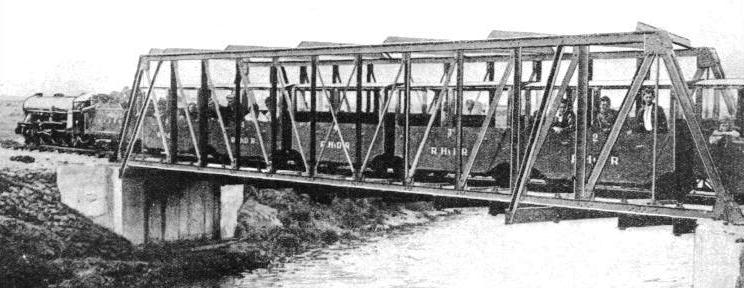
CROSSING A BRIDGE on the Romney, Hythe and Dymchurch 15-in gauge railway. Trains carrying as many as 120 passengers can travel at speeds of twenty-five to thirty miles an hour on this line.
You can read more about “Model Loco Trials at Eskdale”, “A New Miniature Railway” and
“Railway Curiosities” on this website.














